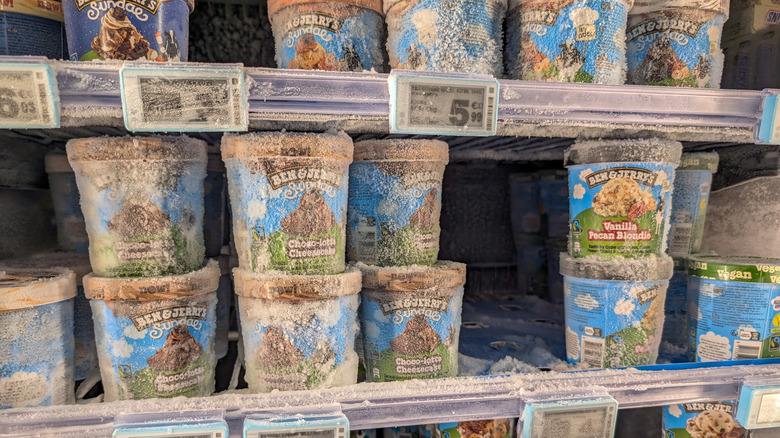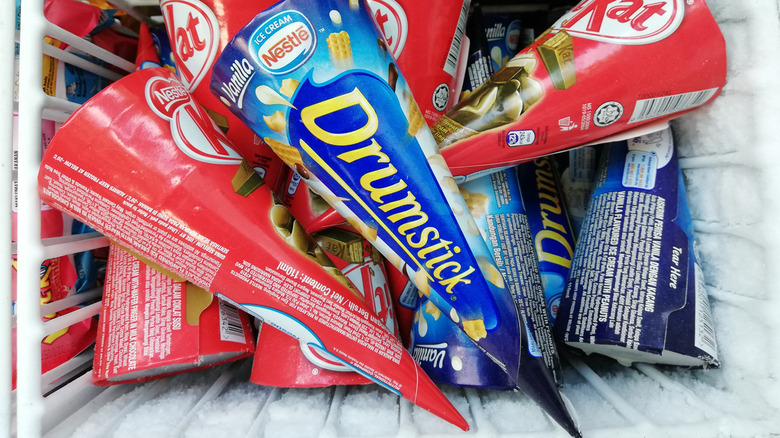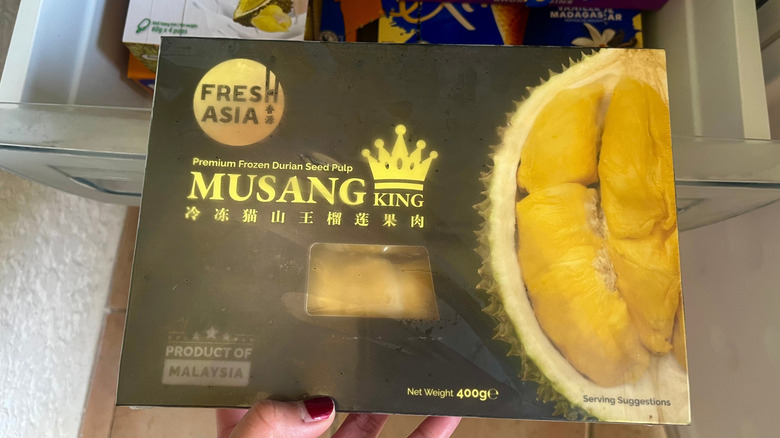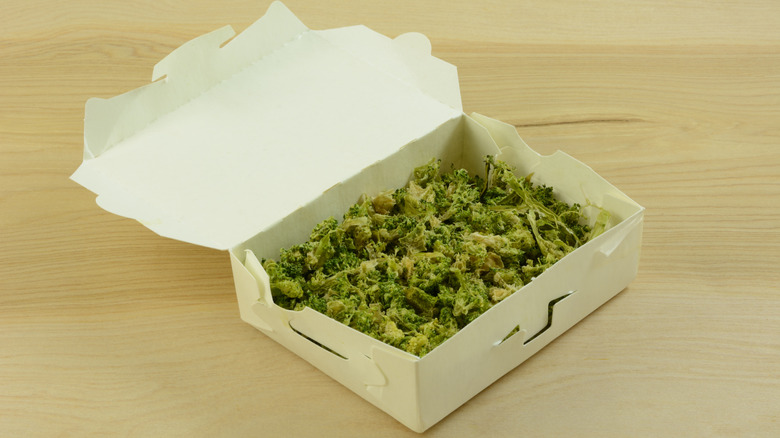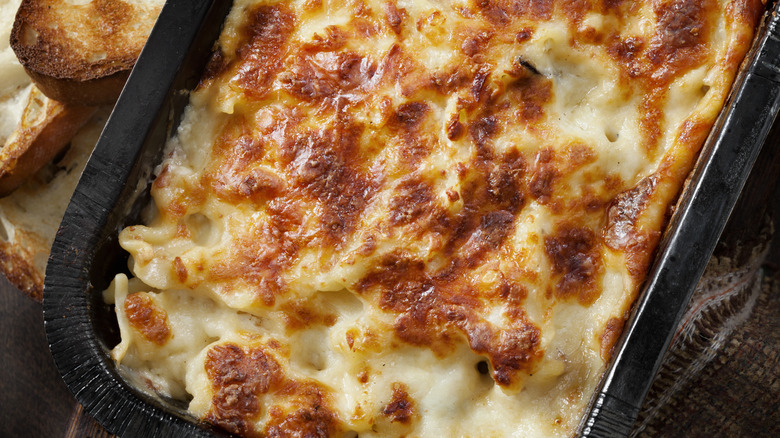11 Major Red Flags To Look Out For When Buying Frozen Foods
Frozen food might seem like it's always safe to eat and lasts forever, but there's more to it than that. Things can go wrong in the freezing process that makes your food less than perfect before it's even left the store. There are some major red flags to look out for when buying frozen food that it's important to consider.
The condition of the food and the packaging can often give you a clue as to its quality without even looking inside, which helps you avoid subpar food. But you have to know what to look out for. Damaged packaging, clumping, and frost buildup can all be signs that a particular product isn't a good one to buy. Then, there are signs with the freezers themselves that might indicate the food inside isn't at its best.
Some of these frozen food red flags simply indicate food might not be safe to consume. For instance, food with freezer burn is safe to eat, it just doesn't taste as good. But other signs can indicate food that's unsafe to eat, such as it might have bacterial regrowth or have fully defrosted and refrozen. It's not worth risking your health on dodgy frozen food, nor do you want to eat flavorless meals, so be aware of the factors to look out for.
1. Damaged packaging, a loose lid, or lack of seal
When shopping for frozen food, a little extra attention to the packaging can go a long way. Damaged packaging, a loose lid, or a broken seal are all red flags that shouldn't be ignored. These issues can be a sign that the product has been compromised in some way, affecting its quality and potentially its safety.
Damaged packaging could be a hole in the bag or a torn box. You'll find lids on some frozen food, such as tubs of ice cream, and these should be tightly in place. Then, some frozen products have seals, such as sealed boxes, plastic over the tray of a frozen meal, or seals under the lid of an ice cream tub. You should always check that any seals are still in place.
When these seals are broken or the packaging is dented or torn, the contents will likely have been exposed to air. This can lead to freezer burn — a condition where ice crystals form on food's surface, wreaking havoc with its texture and flavor. But it's not just freezer burn you have to worry about with damaged packaging or broken seals. This issue can allow contaminants to enter, increasing the risk of spoilage or foodborne illness. Less likely, but there's also the risk that the food has been tampered with. So, there are plenty of reasons to avoid any products with damaged packaging.
2. Frost or ice crystals
When browsing the frozen food aisle, one thing to watch out for is an excessive amount of ice crystals or frost on the packaging. While a little bit of frost is normal, lots of it can signal that the product has repeatedly thawed and refrozen. This isn't just an aesthetic issue; it's a red flag that the food might have been exposed to temperature fluctuations that can affect quality and safety. You should always skip frozen foods that show signs of refreezing.
When frozen food thaws and refreezes, large ice crystals can form, changing the texture of the food. Vegetables might turn mushy and meats can become tough or dry out in spots. This happens because the ice crystals damage the cell structure of the food, which messes with the texture.
Another issue that can go hand-in-hand with heavy frost buildup is freezer burn. It happens when the moisture inside the food evaporates into the surrounding air leaving behind dehydrated patches. This can make food taste stale or off. While freezer-burned goods aren't harmful to eat, they're not particularly tasty, either.
Then there's the fact that you don't know how long the product thawed for or what temperature it reached. It isn't necessarily dangerous to refreeze food that has thawed, but it has to have been thawed safely and not have sat at room temperature for more than two hours. Since it's impossible to know the journey your food has taken, it's best not to risk it.
3. Clumping inside the packaging
A common mistake people make with frozen vegetables is buying bags of them that are clumped up inside. When you pick up a pack, each veggie should feel loose and distinct, not frozen together. Clumping is a red flag that you should avoid if you want them to taste their best.
If your vegetables are frozen together in lumps, it probably means that they've thawed and been refrozen. It's not the normal way that frozen produce should come in a bag. And the same thing goes for frozen fruit, fries, and any other small items that can clump together. While it's unlikely that these items thawed enough to be dangerous, it's not really worth the risk.
There's also the fact that when veggies are brought below freezing temperatures and frozen once again, this impacts the texture. They can turn out mushy or otherwise not quite right. What's more, they may be freezer burned and, therefore, not taste as good as they should. It only takes a second to check a bag for clumping and it's an easy way to tell that the contents isn't as good as it should be. It can save you from many a subpar vegetable.
4. Bulging or misshapen packaging
When you're strolling down the frozen food aisle, it's important to keep an eye out for bulging or misshapen packaging. While it might seem like a minor detail, it can actually be a red flag for bacterial growth. When bacteria multiply inside a sealed package, they often produce gases as a byproduct. These gases build up pressure, causing the packaging to swell or distort. It's a clear signal that the food inside may not be as safe as it should be.
This issue is particularly concerning because frozen foods are designed to be kept at low temperatures that inhibit bacterial growth. So, it could be a sign that somewhere along the line, the temperature has risen and the product has sat above room temperature for an extended period. Generally, this means that the food inside is unsafe to eat. If it's managed to produce enough gas to swell the packaging, there's probably a lot of bacterial growth going on.
Misshapen packaging often means that the product was mishandled at some point. Even if it isn't unsafe to eat, it's likely had its flavor and texture affected. And though you might sometimes find bulging packets for reasons other than bacterial growth, is it really worth finding out when you could just pack up something else? Whether it's a frozen meal, a container of vegetables, or even seafood, any irregularity like this should make you steer clear of the product altogether.
5. Faded labels
Faded or illegible packaging on frozen food can be something to look out for. If the outside of a plastic bag is all smudged and faded or you're having trouble reading a box because of wrinkling and text that looks like it's been rubbed off, this could be a problem. You should think about why this might be and question whether the food inside is still good to eat.
It might seem like a just cosmetic flaw, but this can actually be a sign that the product has been sweating. Sweating happens when condensation forms on the outside of the package due to exposure to higher-than-recommended temperatures in the freezer. When frozen food isn't kept consistently cold, the changing temperatures makes moisture accumulate on the packaging surface.
This extra moisture doesn't just affect the way it looks, it can also be an indicator that the food isn't as good as it should be. At best, the food inside could be less tasty than it should be or have an odd texture. At worst, it could have sat at too-warm temperatures for too long and be unsafe to eat.
Then, there's the fact that you actually want to be able to read the packaging. From prepared meals to tubs of ice cream, the packaging of frozen foods isn't just about branding. Consumers need to be able to read important information like expiration dates and ingredient lists. If you can't make out this information, pick up another package.
6. Frost build-up in the grocery store freezer
When you spot a heavy layer of frost building up in a grocery store's freezer, it's more than just a looks thing, it's a serious red flag. Frost buildup can mean the freezer isn't maintaining a consistently low temperature. Often, this happens when the door is opened a lot or held open too long, or if there's a malfunction in the cooling system. When the temperature fluctuates, moisture in the air condenses and forms frost, which can eventually affect the quality of the food stored inside.
Excessive frost not only makes it harder for store employees to keep the freezer clean, but it can also lead to food quality issues. As frost builds up, it can create a barrier between the food and the cold air, making it more difficult for the product to stay at the right temperature. The food inside might partially thaw and refreeze. In turn, this can cause texture changes and freezer burn.
You need controlled temperatures to keep frozen food in good condition. Frosty freezers suggest that these products might not have been stored correctly, potentially affecting everything from flavor to safety. So, if you notice that the freezer section is heavily frosted, it might be a good idea to steer clear of those items and do your shopping elsewhere.
7. Soft or partially thawed products
There are some things in your freezer that you should throw out — or that you should avoid buying if you're at the grocery store. If you pick up a package and the contents are softer than they ought to be, you should avoid it. Pieces of frozen fish aren't supposed to be bendy and ice cream shouldn't be soft enough that you can squidge the carton — if it is, that's a sign something isn't quite right.
Anything that can be frozen solid should be. And while it's not necessarily unsafe to refreeze partially thawed foods, it's a definite red flag. There are rules to thawing and refreezing food. If food is totally thawed, gets warmed up to room temperature, or is held at room temperature for more than two hours, it's always better to throw it out. The food isn't definitely bad to eat but it isn't worth risking it.
The trouble when you're buying food from the store is that you don't know its journey. If it feels soft when it shouldn't be, it might have only partially thawed for a small length of time and would be fine to refreeze but there's no way of telling, so you should err on the side of caution and look for something that's frozen solid instead.
8. Freezer doors that don't close properly or have been left open
When you notice freezer doors that won't close tightly or appear to have been left open at your local grocery store, it's a clear warning sign that the storage conditions aren't right. The cold environment that's needed to keep frozen products at the proper quality is disrupted. A door that doesn't seal properly lets warm air seep in, causing the temperature to rise, affecting the food inside.
Unstable temperatures can trigger a cycle of partial thawing and refreezing for the items stored within. This messes with the texture and flavor of frozen foods, turning what should be a crisp mushy and what should be flavorful tasteless. An open or faulty freezer also leads to higher humidity levels inside the compartment. It causes frost to build up and may lead to freezer burn.
It's a bad sign overall when the freezer door at a grocery store isn't shutting properly and doesn't leave you trusting of the store in general. It's a different matter if it's been left open by other customers but still can mean that the quality of the food has deteriorated. Or, worse, that the food inside isn't safe to eat.
9. Dried out edges on frozen meals
When you inspect frozen meals and notice that the edges appear dry and desiccated, it's a significant red flag. Dried out parts equals freezer burn and nobody wants that. Freezer burn effectively dehydrates food as the moisture inside evaporates. This leaves frozen meals flavorless or stale tasting with a drier texture — not what you want from your meal.
Freezer burn usually happens when packaging is damaged in some way, allowing air to reach the food. Sometimes it's obvious when packaging is damaged but occasionally there might be just a tiny pin prick hole that's practically unnoticeable. It can also occur due to changes in temperature and other issues, which is why it's important to know the signs.
If you're shopping and the frozen meal is in clear packaging, you might catch a glimpse of these dry, white edges right there on the shelf, which should raise your concerns. However, more often than not, you only notice the issue once you bring the meal home and open the package.
Discovering freezer burn after purchase can be frustrating but it's hard to avoid. At least if you know what the dried edges mean then you can make the decision whether to eat something that isn't going to taste good or move onto an alternative dinner plan. Any good grocery store should refund you if you've purchased freezer burned food, but whether or not you want to go to the trouble of requesting one is another matter.
10. Discolored foods
When you come across frozen food that looks discolored, something might be wrong with it. When food is properly stored at a consistent, low temperature, it should keep its original color. So, if you notice that meats have taken on an unusual brownish or grayish hue, or vegetables have lost their vibrant tones, it might mean the product has experienced temperature changes or has been exposed to air.
This exposure can lead to oxidation, which is where the food reacts with oxygen, causing changes in color and sometimes flavor. In meats, this might mean a shift from a rich red to a dull brown, suggesting that the product might be less fresh than it appears. Similarly, vegetables may lose their crisp texture and bright color, becoming pale or even slightly translucent. These visual cues are essential because they hint at underlying issues like freezer burn or repeated thawing and refreezing.
The best way to prevent freezer burn is wrapping food tightly and avoiding damaged packaging, but before you buy the food, this isn't up to you. Due to opaque packaging, you usually won't spot discoloration before buying food. But avoiding other signs of freezer burn, like ice crystals and torn packaging, is a good start. Discoloration doesn't necessarily mean the food is unsafe, it's a good idea to be cautious. If nothing else, the flavor texture may be off.
11. Unusual texture in frozen foods
While you can't spot an unusual texture before buying, it's a sign you should throw away that frozen food. While this can be annoying — letting something go to waste and having to come up with another dinner plan — it's a red flag that there could be something up with the food.
While incorrect texture, such as mushy vegetables or grainy ice cream, is usually just a result of freezer burn or slight temperature fluctuations, it can be a symptom of a greater issue. When food thaws and refreezes, this affects the texture. It doesn't necessarily mean the food is unsafe, but there is some question over how long it spent at room temperature and whether it reached the temperature danger zone before being frozen again.
In the best case, it's simply a surface level issue. The texture is a little weird and it might ruin it a bit but it's ultimately fine. However, if you notice any other problems, like your food tasting or smelling off when cooked, it might indicate it's not safe to eat. So, be cautious with any textural changes in frozen food and if in doubt, throw it out.


